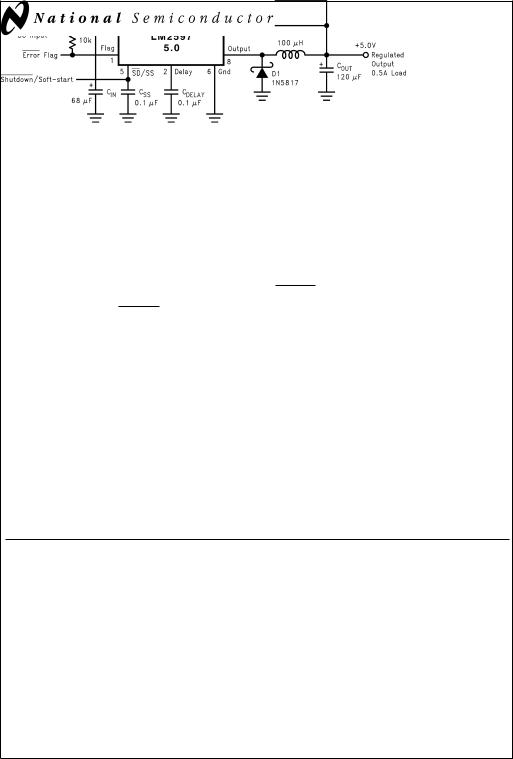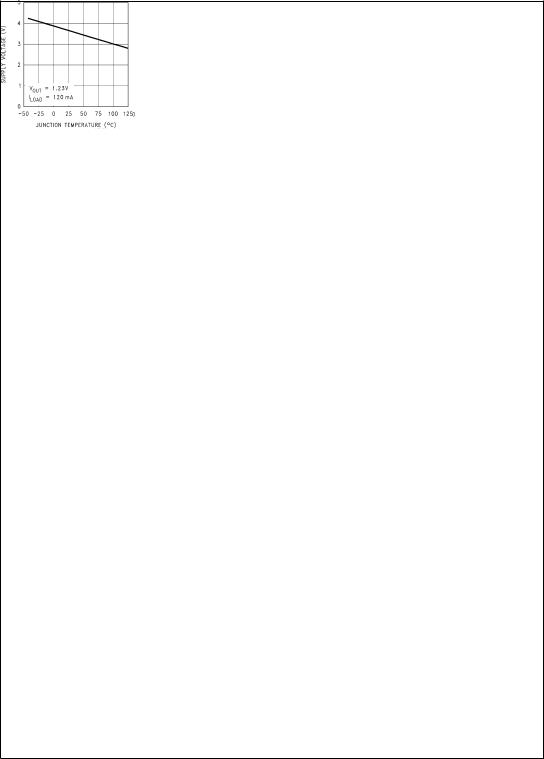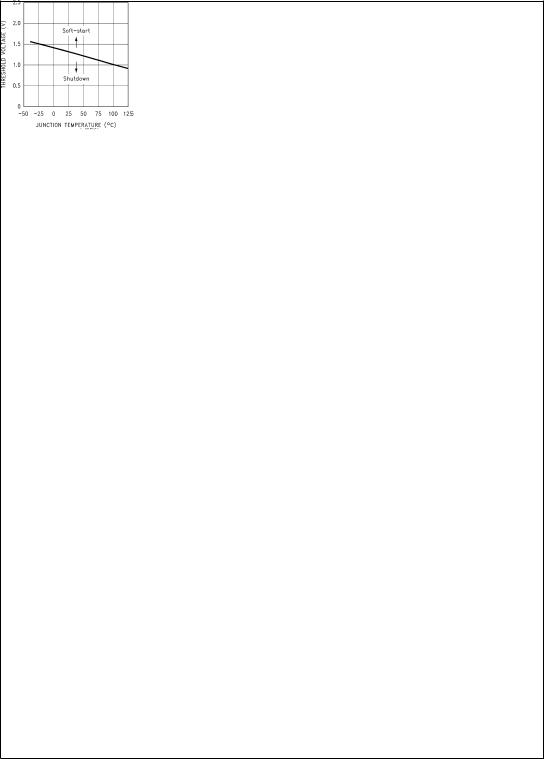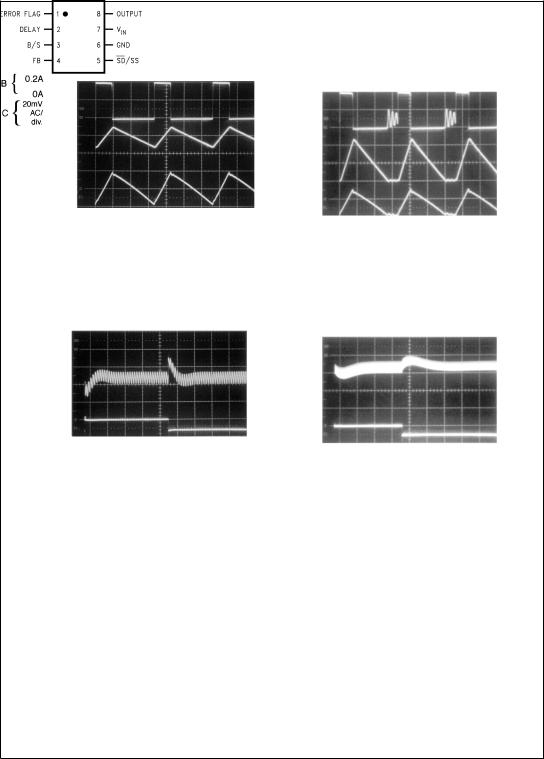NSC LM2597M-12, LM2597HVN-5.0, LM2597HVN-3.3, LM2597HVN-12, LM2597HVMX-ADJ Datasheet
...
March 1998
LM2597/LM2597HV
SIMPLE SWITCHER® Power Converter 150 kHz 0.5A Step-Down Voltage Regulator, with Features
General Description
The LM2597/LM2597HV series of regulators are monolithic integrated circuits that provide all the active functions for a step-down (buck) switching regulator, capable of driving a 0.5A load with excellent line and load regulation. These devices are available in fixed output voltages of 3.3V, 5V, 12V, and an adjustable output version, and are packaged in an 8-lead DIP and an 8-lead surface mount package.
This series of switching regulators is similar to the LM2594 series, with additional supervisory and performance features added.
Requiring a minimum number of external components, these regulators are simple to use and include internal frequency compensation², improved line and load specifications, fixed-frequency oscillator, Shutdown /Soft-start, error flag delay and error flag output.
The LM2597/LM2597HV series operates at a switching frequency of 150 kHz thus allowing smaller sized filter components than what would be needed with lower frequency switching regulators. Because of its high efficiency, the copper traces on the printed circuit board are normally the only heat sinking needed.
A standard series of inductors (both through hole and surface mount types) are available from several different manufacturers optimized for use with the LM2597/LM2597HV series. This feature greatly simplifies the design of switch-mode power supplies.
Other features include a guaranteed ±4% tolerance on output voltage under all conditions of input voltage and output load conditions, and ±15% on the oscillator frequency. External shutdown is included, featuring typically 85 µA standby current. Self protection features include a two stage current limit for the output switch and an over temperature shutdown for complete protection under fault conditions.
The LM2597HV is for use in applications requiring and input voltage up to 60V.
Features
n3.3V, 5V, 12V, and adjustable output versions
nAdjustable version output voltage range, 1.2V to 37V (57V for HV version)±4% max over line and load conditions
nGuaranteed 0.5A output current
nAvailable in 8-pin surface mount and DIP-8 package
nInput voltage range up to 60V
n150 kHz fixed frequency internal oscillator
nShutdown /Soft-start
nOut of regulation error flag
nError output delay
nBias Supply Pin (VBS) for internal circuitry improves efficiency at high input voltages
nLow power standby mode, IQ typically 85 µA
nHigh Efficiency
nUses readily available standard inductors
nThermal shutdown and current limit protection
Applications
nSimple high-efficiency step-down (buck) regulator
nEfficient pre-regulator for linear regulators
nOn-card switching regulators
nPositive to Negative converter
Typical Application (Fixed Output Voltage Versions)
DS012440-1
²Patent Number 5,382,918.
SIMPLE SWITCHER® and Switchers Made Simple ® are registered trademarks of National Semiconductor Corporation.
Voltage Down-Step 5A.0 kHz 150 Converter Power SWITCHER SIMPLE LM2597/LM2597HV
Features with Regulator,
© 1999 National Semiconductor Corporation |
DS012440 |
www.national.com |

Absolute Maximum Ratings (Note 1)
If Military/Aerospace specified devices are required, please contact the National Semiconductor Sales Office/ Distributors for availability and specifications.
Maximum Supply Voltage (VIN) |
|
|
||
|
|
LM2597 |
|
45V |
|
|
LM2597HV |
|
60V |
|
|
6V |
||
|
SD |
/SS Pin Input Voltage (Note 2) |
|
|
Delay Pin Voltage (Note 2) |
|
1.5V |
||
Flag Pin Voltage |
−0.3 |
≤ V ≤45V |
||
Bias Supply Voltage (VBS) |
−0.3 |
≤ V ≤30V |
||
|
Feedback Pin Voltage |
−0.3 |
≤ V ≤+25V |
|
|
Output Voltage to Ground |
|
|
|
|
(Steady State) |
|
−1V |
|
|
Power Dissipation |
Internally limited |
||
|
Storage Temperature Range |
−65ÊC to +150ÊC |
||
ESD Susceptibility |
|
Human Body Model (Note 3) |
2 kV |
Lead Temperature |
|
M8 Package |
|
Vapor Phase (60 sec.) |
+215ÊC |
Infrared (15 sec.) |
+220ÊC |
N Package (Soldering, 10 sec.) |
+260ÊC |
Maximum Junction Temperature |
+150ÊC |
Operating Conditions
Temperature Range |
−40ÊC ≤ TJ +125ÊC |
Supply Voltage |
|
LM2597 |
4.5V to 40V |
LM2597HV |
4.5V to 60V |
LM2597/LM2597HV-3.3
Electrical Characteristics
Specifications with standard type face are for TJ = 25ÊC, and those with boldface type apply over full Operating Temperature Range.VINmax=40V for the LM2597 and 60V for the LM2597HV
Symbol |
Parameter |
Conditions |
LM2597/LM2597HV-3.3 |
Units |
|
|
|
|
|
|
(Limits) |
|
|
|
Typ |
Limit |
|
|
|
|
|
||
|
|
|
(Note 4) |
(Note 5) |
|
|
|
|
|
|
|
SYSTEM PARAMETERS (Note 6) Test Circuit Figure 12 |
|
|
|
||
|
|
|
|
|
|
VOUT |
Output Voltage |
4.75V ≤ VIN ≤ VINmax, 0.1A ≤ ILOAD ≤ 0.5A |
3.3 |
|
V |
|
|
|
|
3.168/3.135 |
V(min) |
|
|
|
|
3.432/3.465 |
V(max) |
|
|
|
|
|
|
η |
Efficiency |
VIN = 12V, ILOAD = 0.5A |
80 |
|
% |
LM2597/LM2597HV-5.0
Electrical Characteristics
Specifications with standard type face are for TJ = 25ÊC, and those with boldface type apply over full Operating Temperature Range.VINmax=40V for the LM2597 and 60V for the LM2597HV
Symbol |
Parameter |
Conditions |
LM2597/LM2597HV-5.0 |
Units |
|
|
|
|
|
|
(Limits) |
|
|
|
Typ |
Limit |
|
|
|
|
|
||
|
|
|
(Note 4) |
(Note 5) |
|
SYSTEM PARAMETERS (Note 6) Test Circuit Figure 12 |
|
|
|
||
|
|
|
|
|
|
VOUT |
Output Voltage |
7V ≤ VIN ≤ VINmax, 0.1A ≤ ILOAD ≤ 0.5A |
5 |
|
V |
|
|
|
|
4.800/4.750 |
V(min) |
|
|
|
|
5.200/5.250 |
V(max) |
η |
Efficiency |
VIN = 12V, ILOAD = 0.5A |
82 |
|
% |
www.national.com |
2 |

LM2597/LM2597HV-12
Electrical Characteristics
Specifications with standard type face are for TJ = 25ÊC, and those with boldface type apply over full Operating Temperature Range.VINmax=40V for the LM2597 and 60V for the LM2597HV
Symbol |
Parameter |
Conditions |
LM2597/LM2597HV-12 |
Units |
|
|
|
|
|
|
(Limits) |
|
|
|
Typ |
Limit |
|
|
|
|
|
||
|
|
|
(Note 4) |
(Note 5) |
|
|
|
|
|
|
|
SYSTEM PARAMETERS (Note 6) Test Circuit Figure 12 |
|
|
|
||
|
|
|
|
|
|
VOUT |
Output Voltage |
15V ≤ VIN ≤ VINmax, 0.1A ≤ ILOAD ≤ 0.5A |
12 |
|
V |
|
|
|
|
11.52/11.40 |
V(min) |
|
|
|
|
12.48/12.60 |
V(max) |
|
|
|
|
||
|
|
|
|
|
|
η |
Efficiency |
VIN = 25V, ILOAD = 0.5A |
88 |
|
% |
LM2597/LM2597HV-ADJ
Electrical Characteristics
Specifications with standard type face are for TJ = 25ÊC, and those with boldface type apply over full Operating Temperature Range.VINmax=40V for the LM2597 and 60V for the LM2597HV
Symbol |
Parameter |
Conditions |
LM2597/LM2597HV-ADJ |
Units |
|
|
|
|
|
|
(Limits) |
|
|
|
Typ |
Limit |
|
|
|
|
|
||
|
|
|
(Note 4) |
(Note 5) |
|
SYSTEM PARAMETERS (Note 6) Test Circuit Figure 12 |
|
|
|
||
|
|
|
|
|
|
VFB |
Feedback Voltage |
4.5V ≤ VIN ≤ VINmax, 0.1A ≤ ILOAD ≤ 0.5A |
1.230 |
|
V |
|
|
VOUT programmed for 3V. Circuit of Figure 12. |
|
1.193/1.180 |
V(min) |
|
|
|
|
1.267/1.280 |
V(max) |
η |
Efficiency |
VIN = 12V, VOUT = 3V, ILOAD = 0.5A |
80 |
|
% |
All Output Voltage Versions
Electrical Characteristics
Specifications with standard type face are for TJ = 25ÊC, and those with boldface type apply over full Operating Temperature Range. Unless otherwise specified, VIN = 12V for the 3.3V, 5V, and Adjustable version and VIN = 24V for the 12V version. ILOAD = 100 mA.
Symbol |
Parameter |
|
|
Conditions |
LM2597/LM2597HV-XX |
Units |
||
|
|
|
|
|
|
|
|
(Limits) |
|
|
|
|
|
|
Typ |
Limit |
|
|
|
|
|
|
|
|
||
|
|
|
|
|
|
(Note 4) |
(Note 5) |
|
|
|
|
|
|
|
|
|
|
DEVICE PARAMETERS |
|
|
|
|
|
|
|
|
|
|
|
|
|
|
|
|
|
Ib |
Feedback Bias Current |
|
Adjustable Version Only, VFB = 1.235V |
10 |
50/100 |
nA |
||
fO |
Oscillator Frequency |
|
(Note 7) |
|
150 |
|
kHz |
|
|
|
|
|
|
|
|
127/110 |
kHz(min) |
|
|
|
|
|
|
|
173/173 |
kHz(max) |
|
|
|
|
|
|
|
|
|
VSAT |
Saturation Voltage |
|
IOUT = 0.5A (Notes 8 and 9) |
0.9 |
|
V |
||
|
|
|
|
|
|
|
1.1/1.2 |
V(max) |
|
|
|
|
|
|
|
|
|
DC |
Max Duty Cycle (ON) |
(Note 9) |
|
100 |
|
% |
||
|
Min Duty Cycle (OFF) |
(Note 10) |
|
0 |
|
|
||
|
|
|
|
|
|
|
|
|
ICL |
Current Limit |
|
Peak Current, (Notes 8 and 9) |
0.8 |
|
A |
||
|
|
|
|
|
|
|
0.65/0.58 |
A(min) |
|
|
|
|
|
|
|
1.3/1.4 |
A(max) |
|
|
|
|
|
|
|
|
|
IL |
Output Leakage Current |
|
(Notes 8, 10 and 11) |
Output = 0V |
|
50 |
µA(max) |
|
|
|
|
Output = −1V |
|
2 |
|
mA |
|
|
|
|
|
|
|
|
15 |
mA(max) |
|
|
|
|
|
|
|
|
|
IQ |
Operating Quiescent |
|
|
5 |
|
mA |
||
|
SD |
/SS Pin Open, VBS Pin Open(Note 10) |
|
|||||
|
Current |
|
|
|
|
|
10 |
mA(max) |
|
|
|
|
|
|
|
|
|
3 |
www.national.com |

All Output Voltage Versions
Electrical Characteristics (Continued)
Specifications with standard type face are for TJ = 25ÊC, and those with boldface type apply over full Operating Temperature Range. Unless otherwise specified, VIN = 12V for the 3.3V, 5V, and Adjustable version and VIN = 24V for the 12V version. ILOAD = 100 mA.
Symbol |
Parameter |
|
|
|
|
|
Conditions |
LM2597/LM2597HV-XX |
Units |
||
|
|
|
|
|
|
|
|
|
|
|
(Limits) |
|
|
|
|
|
|
|
|
|
Typ |
Limit |
|
|
|
|
|
|
|
|
|
|
|
||
|
|
|
|
|
|
|
|
|
(Note 4) |
(Note 5) |
|
|
|
|
|
|
|
|
|
|
|
|
|
DEVICE PARAMETERS |
|
|
|
|
|
|
|
|
|
|
|
|
|
|
|
|
|
|
|
|
|
|
|
ISTBY |
Standby Quiescent |
|
SD |
/SS pin = 0V |
(Note 10)LM2597 |
85 |
|
µA |
|||
|
Current |
|
|
|
|
|
|
|
|
200/250 |
µA(max) |
|
|
|
|
|
|
|
LM2597HV |
140 |
250/300 |
µA(max) |
|
|
|
|
|
|
|
|
|
|
|
||
θJA |
Thermal Resistance |
|
N Package, Junction to Ambient (Note 12) |
95 |
|
ÊC/W |
|||||
|
|
|
M Package, Junction to Ambient (Note 12) |
150 |
|
|
|||||
|
|
|
|
|
|
|
|
|
|
||
SHUTDOWN/SOFT-START CONTROL Test Circuit of Figure 12 |
|
|
|
||||||||
|
|
|
|
|
|
|
|
|
|
|
|
VSD |
Shutdown Threshold |
|
|
|
|
|
|
|
1.3 |
|
V |
|
Voltage |
|
Low, (Shutdown Mode) |
|
|
0.6 |
V(max) |
||||
|
|
|
High, (Soft-start Mode) |
|
|
2 |
V(min) |
||||
|
|
|
|
|
|
|
|
|
|
||
VSS |
Soft-start Voltage |
|
VOUT = 20% of Nominal Output Voltage |
2 |
|
V |
|||||
|
|
|
VOUT = 100% of Nominal Output Voltage |
3 |
|
|
|||||
ISD |
Shutdown Current |
|
V |
|
= 0.5V |
|
5 |
|
µA |
||
|
SHUTDOWN |
|
|
||||||||
|
|
|
|
|
|
|
|
|
|
10 |
µA(max) |
|
|
|
|
|
|
|
|
|
|
|
|
ISS |
Soft-start Current |
|
VSoft-start = 2.5V |
|
|
1.6 |
|
µA |
|||
|
|
|
|
|
|
|
|
|
|
5 |
µA(max) |
|
|
|
|
|
|
|
|
|
|
|
|
FLAG/DELAY CONTROL Test Circuit of Figure 12 |
|
|
|
|
|
||||||
|
Regulator Dropout |
|
Low (Flag ON) |
|
|
96 |
|
% |
|||
|
Detector |
|
|
|
|
|
|
|
|
92 |
%(min) |
|
Threshold Voltage |
|
|
|
|
|
|
|
|
98 |
%(max) |
|
|
|
|
|
|
|
|
|
|
|
|
VFSAT |
Flag Output Saturation |
|
ISINK = 3 mA |
|
|
0.3 |
|
V |
|||
|
Voltage |
VDELAY = 0.5V |
|
|
|
0.7/1.0 |
V(max) |
||||
IFL |
Flag Output Leakage |
|
VFLAG = 40V |
|
|
0.3 |
|
µA |
|||
|
Current |
|
|
|
|
|
|
|
|
|
|
|
|
|
|
|
|
|
|
|
|
|
|
|
Delay Pin Threshold |
|
|
|
|
|
|
|
1.25 |
|
V |
|
Voltage |
Low (Flag ON) |
|
|
|
1.21 |
V(min) |
||||
|
|
High (Flag OFF) and VOUT Regulated |
|
1.29 |
V(max) |
||||||
|
Delay Pin Source |
VDELAY = 0.5V |
|
|
3 |
|
µA |
||||
|
Current |
|
|
|
|
|
|
|
|
6 |
µA(max) |
|
|
|
|
|
|
|
|
|
|
|
|
|
Delay Pin Saturation |
Low (Flag ON) |
|
|
55 |
|
mV |
||||
|
|
|
|
|
|
|
|
|
|
350/400 |
mV(max) |
|
|
|
|
|
|
|
|
|
|
|
|
BIAS SUPPLY |
|
|
|
|
|
|
|
|
|
|
|
|
|
|
|
|
|
|
|
|
|
|
|
IBS |
Bias Supply Pin Current |
|
VBS = 2V |
(Note 10) |
120 |
|
µA |
||||
|
|
|
|
|
|
|
|
|
|
400 |
µA(max) |
|
|
|
VBS = 4.4V (Note 10) |
|
4 |
|
mA |
||||
|
|
|
|
|
|
|
|
|
|
10 |
mA(max) |
|
|
|
|
|
|
|
|
|
|
||
IQ |
Operating Quiescent |
|
VBS = 4.4V , Vin pin current(Note 10) |
1 |
2 |
mA |
|||||
|
Current |
|
|
|
|
|
|
|
|
|
|
|
|
|
|
|
|
|
|
|
|
|
|
Note 1: Absolute Maximum Ratings indicate limits beyond which damage to the device may occur. Operating Ratings indicate conditions for which the device is intended to be functional, but do not guarantee specific performance limits. For guaranteed specifications and test conditions, see the Electrical Characteristics.
Note 2: Voltage internally clamped. If clamp voltage is exceeded, limit current to a maximum of 1 mA.
Note 3: The human body model is a 100 pF capacitor discharged through a 1.5k resistor into each pin.
Note 4: Typical numbers are at 25ÊC and represent the most likely norm.
Note 5: All limits guaranteed at room temperature (standard type face) and at temperature extremes (bold type face). All room temperature limits are 100% production tested. All limits at temperature extremes are guaranteed via correlation using standard Statistical Quality Control (SQC) methods. All limits are used to calculate Average Outgoing Quality Level (AOQL).
www.national.com |
4 |

All Output Voltage Versions
Electrical Characteristics (Continued)
Note 6: External components such as the catch diode, inductor, input and output capacitors can affect switching regulator system performance. When the LM2597/ LM2597HV is used as shown in the Figure 12 test circuit, system performance will be as shown in system parameters section of Electrical Characteristics.
Note 7: The switching frequency is reduced when the second stage current limit is activated. The amount of reduction is determined by the severity of current overload.
Note 8: No diode, inductor or capacitor connected to output pin.
Note 9: Feedback pin removed from output and connected to 0V to force the output transistor switch ON.
Note 10: Feedback pin removed from output and connected to 12V for the 3.3V, 5V, and the ADJ. version, and 15V for the 12V version, to force the output transistor switch OFF.
Note 11: VIN = 40V for the LM2597 and 60V for the LM2597HV.
Note 12: Junction to ambient thermal resistance with approximately 1 square inch of printed circuit board copper surrounding the leads. Additional copper area will lower thermal resistance further. See application hints in this data sheet and the thermal model in Switchers Made Simple ™ software.
Typical Performance Characteristics
Normalized |
Line Regulation |
Efficiency |
Output Voltage |
|
|
|
DS012440-3 |
DS012440-4 |
|
DS012440-2 |
|
Switch Saturation |
Switch Current Limit |
Dropout Voltage |
Voltage |
|
|
|
DS012440-6 |
DS012440-7 |
|
DS012440-5 |
|
Quiescent Current |
Standby |
Minimum Operating |
|
Quiescent Current |
Supply Voltage |
DS012440-8
DS012440-9 |
DS012440-10 |
5 |
www.national.com |

Typical Performance Characteristics (Continued)
Feedback Pin |
Flag Saturation |
Switching Frequency |
Bias Current |
Voltage |
|
DS012440-13
DS012440-11 |
|
|
DS012440-12 |
|
|
|
|
Soft-start |
Shutdown /Soft-start |
Delay Pin Current |
|
|
Current |
|
|
|
DS012440-14 |
|
|
DS012440-16 |
|
|
DS012440-15 |
||
|
|
|
|
|
VIN and VBS Current vs |
Soft-start Response |
|
Shutdown /Soft-start |
|
VBS and Temperature |
|
|
Threshold Voltage |
|
DS012440-18
DS012440-17 |
DS012440-25 |
www.national.com |
6 |

Typical Performance Characteristics (Continued)
Continuous Mode Switching Waveforms |
Discontinuous Mode Switching Waveforms |
VIN = 20V, VOUT = 5V, ILOAD = 400 mA |
|
L = 100 µH, C OUT = 120 µF, C OUT ESR = 140 mΩ |
VIN = 20V, VOUT = 5V, ILOAD = 200 mA |
|
L = 33 µH, C OUT = 220 µF, C OUT ESR = 60 mΩ |
DS012440-19
A:Output Pin Voltage, 10V/div.
B:Inductor Current 0.2A/div.
C:Output Ripple Voltage, 20 mV/div.
Horizontal Time Base: 2 µs/div.
Load Transient Response for Continuous Mode
VIN = 20V, VOUT = 5V, ILOAD = 200 mA to 500 mA L = 100 µH, C OUT = 120 µF, C OUT ESR = 140 mΩ
DS012440-21
A:Output Voltage, 50 mV/div. (AC)
B:200 mA to 500 mA Load Pulse
Horizontal Time Base: 50 µs/div.
DS012440-20
A:Output Pin Voltage, 10V/div.
B:Inductor Current 0.2A/div.
C:Output Ripple Voltage, 20 mV/div.
Horizontal Time Base: 2 µs/div.
Load Transient Response for Discontinuous Mode
VIN = 20V, VOUT = 5V, ILOAD = 100 mA to 200 mA L = 33 µH, C OUT = 220 µF, C OUT ESR = 60 mΩ
DS012440-22
A:Output Voltage, 50 mV/div. (AC)
B:100 mA to 200 mA Load Pulse
Horizontal Time Base: 200 µs/div.
Connection Diagrams and Ordering Information
8±Lead DIP (N)
8±Lead Surface Mount (M)
DS012440-23
DS012440-24
Top View
Order Number LM2597N-3.3,
Top View
LM2597N-5.0, LM2597N-12 or
Order Number LM2597M-3.3,
LM2597N-ADJ
LM2597M-5.0, LM2597M-12 or
LM2597HVN-3.3, LM2597HVN-5.0,
LM2597M-ADJ
LM2597HVN-12 or LM2597HVN-ADJ
LM2597HVM-3.3, LM2597HVM-5.0,
See NS Package Number N08E
LM2597HVM-12 or LM2597HVM-ADJ
See NS Package Number M08A
7 |
www.national.com |

LM2597/LM2597HV Series Buck Regulator Design Procedure (Fixed
Output)
PROCEDURE (Fixed Output Voltage Version) |
EXAMPLE (Fixed Output Voltage Version) |
|||
|
|
|
|
|
Given: |
Given: |
|
|
|
VOUT = Regulated Output Voltage (3.3V, 5V or 12V) |
VOUT = 5V |
|
|
|
VIN(max) = Maximum DC Input Voltage |
VIN(max) = 12V |
|
||
ILOAD(max) = Maximum Load Current |
ILOAD(max) = 0.4A |
|
||
1. Inductor Selection (L1) |
1. Inductor Selection (L1) |
|||
A. Select the correct inductor value selection guide from Fig- |
A. Use the inductor selection guide for the 5V version shown |
|||
ure 3, Figure 4, or Figure 5. (Output voltages of 3.3V, 5V, or |
in Figure 4. |
|
|
|
12V respectively.) For all other voltages, see the design pro- |
B. From the inductor value selection guide shown in Figure 4, |
|||
cedure for the adjustable version. |
the inductance region intersected by the 12V horizontal line |
|||
B. From the inductor value selection guide, identify the induc- |
and the 0.4A vertical line is 100 µH, and the inductor code is |
|||
tance region intersected by the Maximum Input Voltage line |
L20. |
|
|
|
and the Maximum Load Current line. Each region is identified |
C. The inductance value required is 100 µH. From the table in |
|||
by an inductance value and an inductor code (LXX). |
Figure 7, go to the L20 line and choose an inductor part num- |
|||
|
||||
C. Select an appropriate inductor from the four manufacturer's |
ber from any of the four manufacturers shown. (In most in- |
|||
part numbers listed in Figure 7. |
stance, both through hole and surface mount inductors are |
|||
|
available.) |
|
|
|
2. Output Capacitor Selection (COUT) |
2. Output Capacitor Selection (COUT) |
|||
A. In the majority of applications, low ESR (Equivalent Series |
A. See section on output capacitors in application infor- |
|||
Resistance) electrolytic capacitors between 82 µF and 220 µF |
mation section. |
|
||
and low ESR solid tantalum capacitors between 15 µF and |
B. From the quick design component selection table shown in |
|||
100 µF provide the best results. This capacitor should be lo- |
Figure 1, locate the 5V output voltage section. In the load cur- |
|||
cated close to the IC using short capacitor leads and short |
||||
rent column, choose the load current line that is closest to the |
||||
copper traces. Do not use capacitors larger than 220 µF. |
||||
current needed in your application, for this example, use the |
||||
|
||||
For additional information, see section on output capaci- |
0.5A line. In the maximum input voltage column, select the |
|||
tors in application information section. |
line that covers the input voltage needed in your application, |
|||
B. To simplify the capacitor selection procedure, refer to the |
in this example, use the 15V line. Continuing on this line are |
|||
quick design component selection table shown in Figure 1. |
recommended inductors and capacitors that will provide the |
|||
This table contains different input voltages, output voltages, |
best overall performance. |
|||
|
|
|
||
and load currents, and lists various inductors and output ca- |
The capacitor list contains both through hole electrolytic and |
|||
pacitors that will provide the best design solutions. |
surface mount tantalum capacitors from four different capaci- |
|||
C. The capacitor voltage rating for electrolytic capacitors |
tor manufacturers. It is recommended that both the manufac- |
|||
should be at least 1.5 times greater than the output voltage, |
turers and the manufacturer's series that are listed in the table |
|||
be used. |
|
|
||
and often much higher voltage ratings are needed to satisfy |
|
|
||
|
|
|
||
the low ESR requirements for low output ripple voltage. |
In this example aluminum electrolytic capacitors from several |
|||
D. For computer aided design software, see Switchers Made |
different manufacturers are available with the range of ESR |
|||
Simple® version 4.1 or later). |
numbers needed. |
|
||
|
120 µF |
25V |
Panasonic HFQ Series |
|
|
120 µF |
25V |
Nichicon PL Series |
|
|
C. For a 5V output, a capacitor voltage rating at least 7.5V or |
|||
|
more is needed. But, in this example, even a low ESR, switch- |
|||
|
ing grade, 120 µF 10V aluminum electrolytic capacitor would |
|||
|
exhibit approximately 400 mΩ of ESR (see the curve in Figure |
|||
|
16 for the ESR vs voltage rating). This amount of ESR would |
|||
|
result in relatively high output ripple voltage. To reduce the |
|||
|
ripple to 1% of the output voltage, or less, a capacitor with a |
|||
|
higher voltage rating (lower ESR) should be selected. A 16V |
|||
|
or 25V capacitor will reduce the ripple voltage by approxi- |
|||
|
mately half. |
|
|
|
|
|
|
|
|
www.national.com |
8 |

LM2597/LM2597HV Series Buck Regulator Design Procedure (Fixed
Output) (Continued)
PROCEDURE (Fixed Output Voltage Version) |
EXAMPLE (Fixed Output Voltage Version) |
3. Catch Diode Selection (D1) |
3. Catch Diode Selection (D1) |
A. The catch diode current rating must be at least 1.3 times |
A. Refer to the table shown in Figure 10. In this example, a |
greater than the maximum load current. Also, if the power |
1A, 20V, 1N5817 Schottky diode will provide the best perfor- |
supply design must withstand a continuous output short, the |
mance, and will not be overstressed even for a shorted out- |
diode should have a current rating equal to the maximum cur- |
put. |
rent limit of the LM2597. The most stressful condition for this |
|
diode is an overload or shorted output condition. |
|
B.The reverse voltage rating of the diode should be at least 1.25 times the maximum input voltage.
C.This diode must be fast (short reverse recovery time) and must be located close to the LM2597 using short leads and short printed circuit traces. Because of their fast switching speed and low forward voltage drop, Schottky diodes provide the best performance and efficiency, and should be the first choice, especially in low output voltage applications. Ultra-fast recovery, or High-Efficiency rectifiers also provide good results. Ultra-fast recovery diodes typically have reverse recovery times of 50 ns or less. Rectifiers such as the 1N4001 series are much too slow and should not be used.
4. Input Capacitor (CIN) |
4. Input Capacitor (CIN) |
|
A low ESR aluminum or tantalum bypass capacitor is needed |
The important parameters for the Input capacitor are the input |
|
between the input pin and ground to prevent large voltage |
voltage rating and the RMS current rating. With a nominal in- |
|
transients from appearing at the input. In addition, the RMS |
put voltage of 12V, an aluminum electrolytic capacitor with a |
|
current rating of the input capacitor should be selected to be |
voltage rating greater than 18V (1.5 x VIN) would be needed. |
|
at least 1¤2 the DC load current. The capacitor manufacturers |
The next higher capacitor voltage rating is 25V. |
|
data sheet must be checked to assure that this current rating |
The RMS current rating requirement for the input capacitor in |
|
is not exceeded. The curve shown in Figure 15 shows typical |
a buck regulator is approximately 1¤2 the DC load current. In |
|
RMS current ratings for several different aluminum electrolytic |
this example, with a 400 mA load, a capacitor with a RMS cur- |
|
capacitor values. |
rent rating of at least 200 mA is needed. The curves shown in |
|
This capacitor should be located close to the IC using short |
Figure 15 can be used to select an appropriate input capaci- |
|
leads and the voltage rating should be approximately 1.5 |
tor. From the curves, locate the 25V line and note which ca- |
|
times the maximum input voltage. |
pacitor values have RMS current ratings greater than 200 mA. |
|
If solid tantalum input capacitors are used, it is recommended |
Either a 47 µF or 68 µF, 25V capacitor could be used. |
|
that they be surge current tested by the manufacturer. |
For a through hole design, a 68 µF/25V electrolytic capacitor |
|
Use caution when using ceramic capacitors for input bypass- |
(Panasonic HFQ series or Nichicon PL series or equivalent) |
|
ing, because it may cause severe ringing at the VIN pin. |
would be adequate. Other types or other manufacturers ca- |
|
For additional information, see section on input capaci- |
pacitors can be used provided the RMS ripple current ratings |
|
are adequate. |
||
tors in Application Information section. |
||
For surface mount designs, solid tantalum capacitors are rec- |
||
|
||
|
ommended. The TPS series available from AVX, and the |
|
|
593D series from Sprague are both surge current tested. |
9 |
www.national.com |

LM2597/LM2597HV Series Buck Regulator Design Procedure (Fixed
Output) (Continued)
|
Conditions |
|
Inductor |
|
Output Capacitor |
|
|||
|
|
|
|
|
|
|
|
|
|
|
|
|
|
|
|
Through Hole |
Surface Mount |
||
|
|
|
|
|
|
|
|
|
|
Output |
Load |
|
Max Input |
Inductance |
Inductor |
Panasonic |
Nichicon |
AVX TPS |
Sprague |
Voltage |
Current |
|
Voltage |
(µH) |
( #) |
HFQ Series |
PL Series |
Series |
595D Series |
(V) |
(A) |
|
(V) |
|
|
(µF/V) |
(µF/V) |
(µF/V) |
(µF/V) |
|
|
|
|
|
|
|
|
|
|
3.3 |
0.5 |
|
5 |
33 |
L14 |
220/16 |
220/16 |
100/16 |
100/6.3 |
|
|
|
|
|
|
|
|
|
|
|
|
|
7 |
47 |
L13 |
120/25 |
120/25 |
100/16 |
100/6.3 |
|
|
|
|
|
|
|
|
|
|
|
|
|
10 |
68 |
L21 |
120/25 |
120/25 |
100/16 |
100/6.3 |
|
|
|
40 |
100 |
L20 |
120/35 |
120/35 |
100/16 |
100/6.3 |
|
|
|
|
|
|
|
|
|
|
|
|
|
6 |
68 |
L4 |
120/25 |
120/25 |
100/16 |
100/6.3 |
|
|
|
|
|
|
|
|
|
|
|
0.2 |
|
10 |
150 |
L10 |
120/16 |
120/16 |
100/16 |
100/6.3 |
|
|
|
|
|
|
|
|
|
|
|
|
|
40 |
220 |
L9 |
120/16 |
120/16 |
100/16 |
100/6.3 |
5 |
0.5 |
|
8 |
47 |
L13 |
180/16 |
180/16 |
100/16 |
33/25 |
|
|
|
|
|
|
|
|
|
|
|
|
|
10 |
68 |
L21 |
180/16 |
180/16 |
100/16 |
33/25 |
|
|
|
|
|
|
|
|
|
|
|
|
|
15 |
100 |
L20 |
120/25 |
120/25 |
100/16 |
33/25 |
|
|
|
|
|
|
|
|
|
|
|
|
|
40 |
150 |
L19 |
120/25 |
120/25 |
100/16 |
33/25 |
|
|
|
|
|
|
|
|
|
|
|
|
|
9 |
150 |
L10 |
82/16 |
82/16 |
100/16 |
33/25 |
|
|
|
|
|
|
|
|
|
|
|
0.2 |
|
20 |
220 |
L9 |
120/16 |
120/16 |
100/16 |
33/25 |
|
|
|
|
|
|
|
|
|
|
|
|
|
40 |
330 |
L8 |
120/16 |
120/16 |
100/16 |
33/25 |
|
|
|
|
|
|
|
|
|
|
12 |
0.5 |
|
15 |
68 |
L21 |
82/25 |
82/25 |
100/16 |
15/25 |
|
|
|
|
|
|
|
|
|
|
|
|
|
18 |
150 |
L19 |
82/25 |
82/25 |
100/16 |
15/25 |
|
|
|
|
|
|
|
|
|
|
|
|
|
30 |
220 |
L27 |
82/25 |
82/25 |
100/16 |
15/25 |
|
|
|
|
|
|
|
|
|
|
|
|
|
40 |
330 |
L26 |
82/25 |
82/25 |
100/16 |
15/25 |
|
|
|
|
|
|
|
|
|
|
|
|
|
15 |
100 |
L11 |
82/25 |
82/25 |
100/16 |
15/25 |
|
|
|
|
|
|
|
|
|
|
|
0.2 |
|
20 |
220 |
L9 |
82/25 |
82/25 |
100/16 |
15/25 |
|
|
|
|
|
|
|
|
|
|
|
|
|
40 |
330 |
L17 |
82/25 |
82/25 |
100/16 |
15/25 |
|
|
|
|
|
|
|
|
|
|
FIGURE 1. LM2597/LM2597HV Fixed Voltage Quick Design Component Selection Table
www.national.com |
10 |
